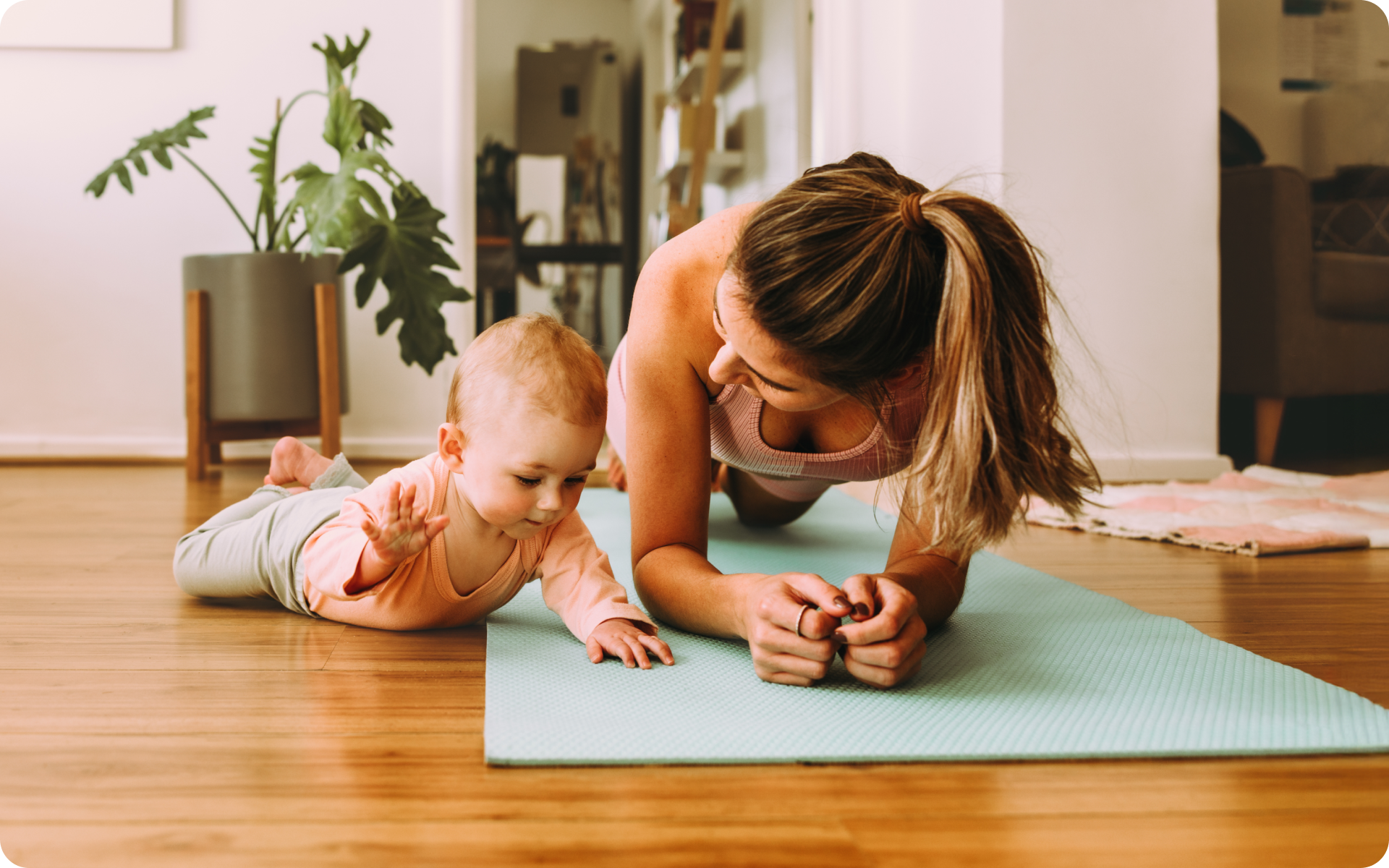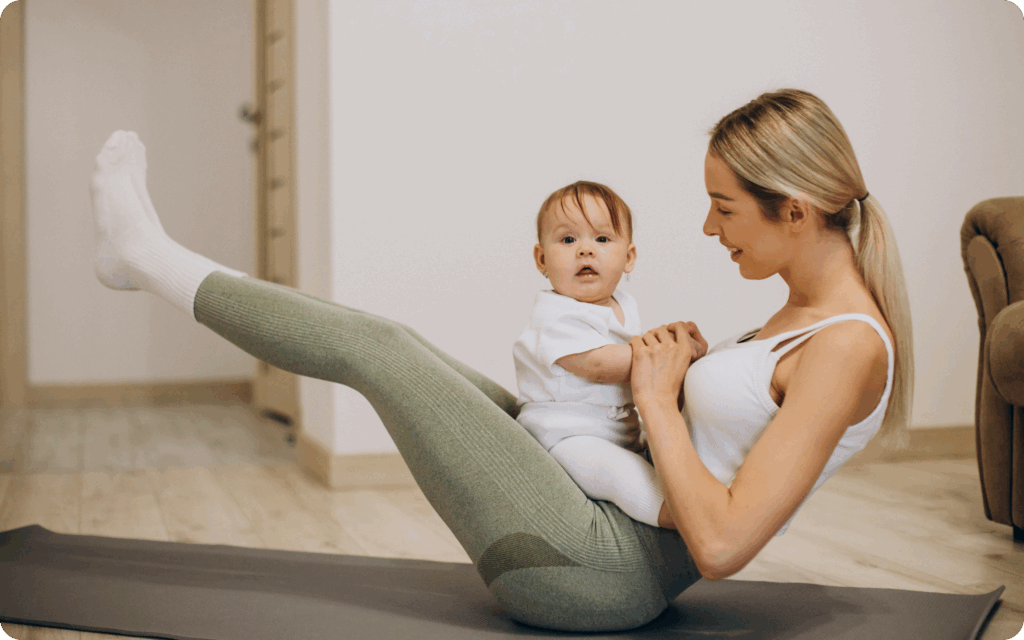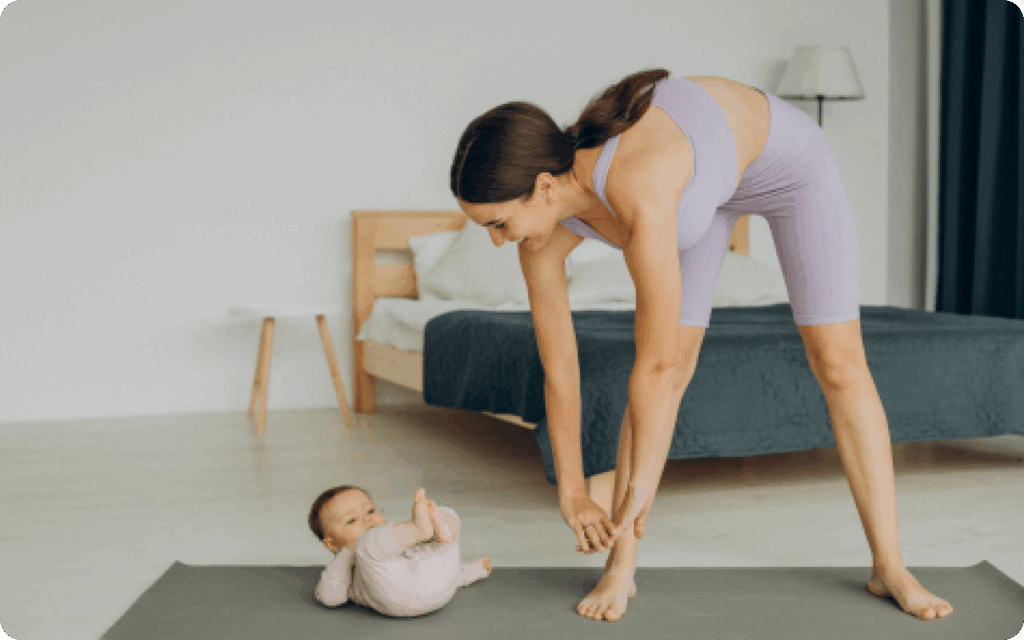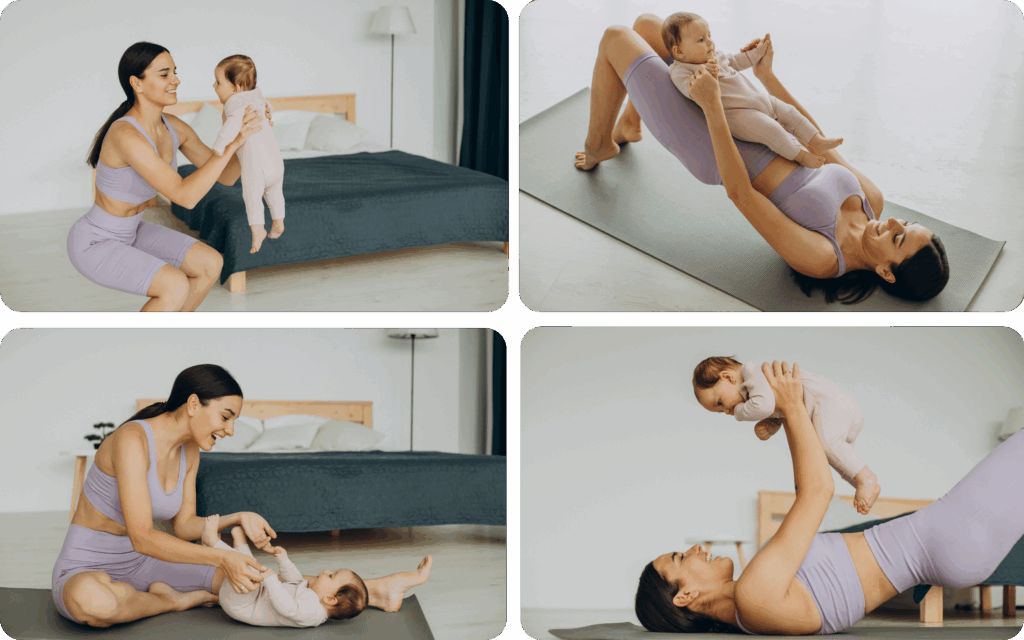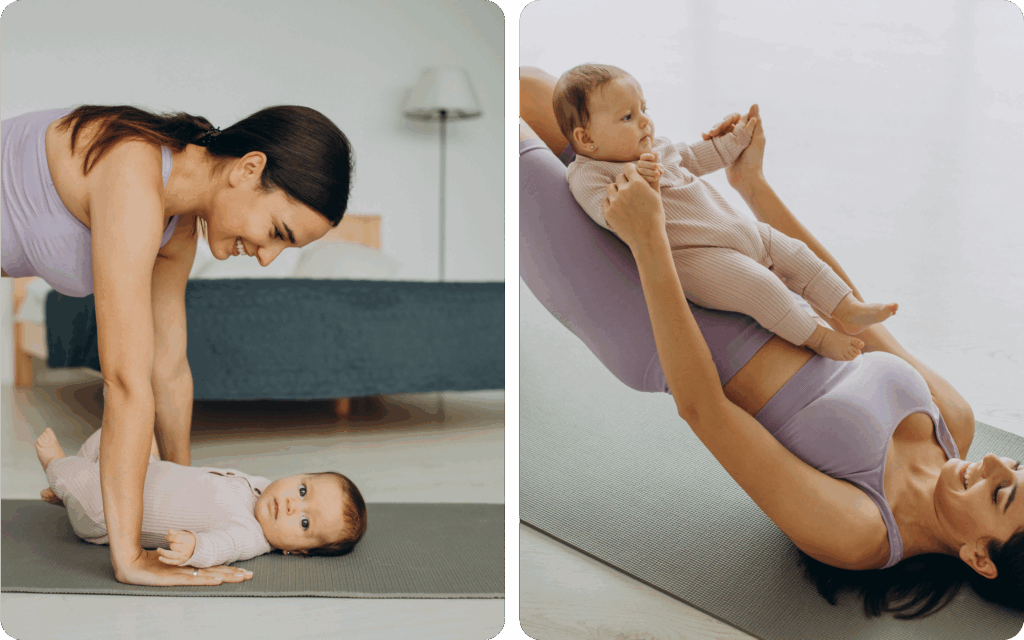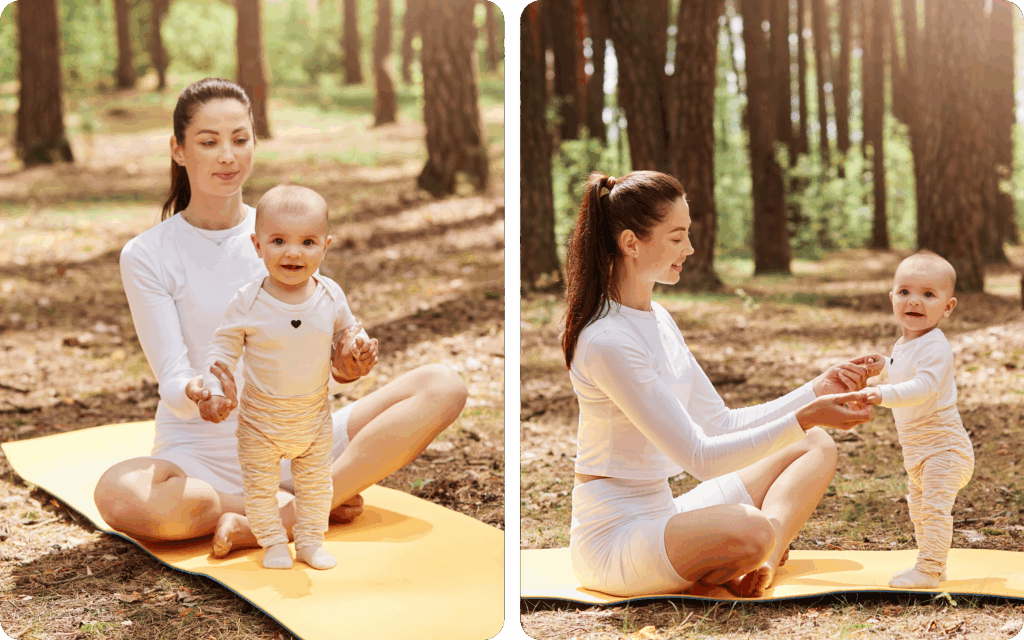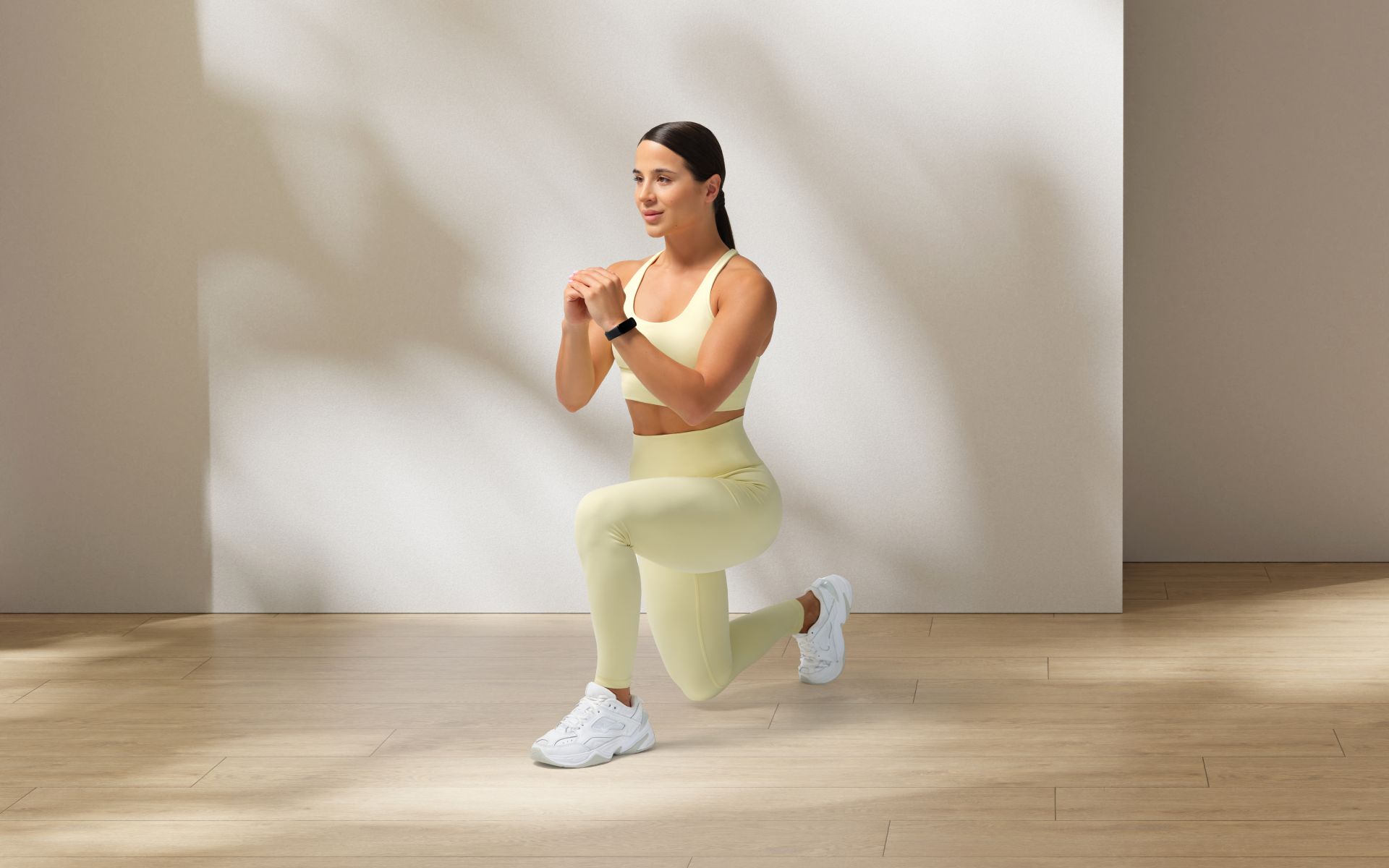Having a baby changes everything, including your body. After childbirth, it’s normal to feel weak, tired, or unsure how to move again. A gentle postpartum exercise plan helps you support recovery, regain strength, and feel confident in your body again.
Patience is key. You don’t need high-intensity workouts to see progress – just the right steps at the right time. This guide explains when to start exercising, what moves are most caring, and how to support the gradual restoration of your core and pelvic floor. Always get clearance from your OB/GYN before you start any workout (1).
Why a Postpartum Exercise Plan Matters
Your body goes through major changes during pregnancy and childbirth. Muscles stretch, joints loosen, and hormones shift. Many women feel soreness, back discomfort, or weak core muscles for weeks afterward.
A postpartum exercise routine helps you encourage renewal and rebuild your body mindfully. It improves posture, energy, and mental health while reducing discomfort and fatigue (2). Regular movement also supports blood flow and speeds up recovery (3).
But remember, this isn’t about “bouncing back”, it’s about feeling stronger, supported, and balanced in your new body. Small, consistent actions bring lasting results.
Mentally, movement releases endorphins – natural mood boosters that help manage stress and prevent postpartum blues (4). Even short walks (extra points if performed with a baby carrier) or breathing exercises can lift your energy and focus. Regular physical activity may also ease worry, support emotional balance, and improve how you feel in your postpartum body.
Building a realistic postpartum exercise program gives new moms structure and confidence as they recover. The goal isn’t perfection, it’s to restore your body’s function, confidence, and health at your own pace.
Read more: Pregnancy Cardio Workout: Everything You Need to Know to Do It Safely
What Is an Effective Postpartum Exercise Plan?
A good plan balances well-being, recovery, and strength. It meets you where you are, not where you were before your pregnancy.
The Foundation
A supportive plan starts with your breath and posture. Deep core breathing rebuilds internal strength and reconnects your pelvic floor (5). Posture drills help stabilize your back and support your abs.
Start with breathing and core reactivation. These small steps rebuild the muscles that stabilize your back and pelvis. Lie on your back, and really try to connect with your body, including your core and pelvic floor.
Reasons why BetterMe is a safe bet: a wide range of calorie-blasting workouts, finger-licking recipes, 24/7 support, challenges that’ll keep you on your best game, and that just scratches the surface! Start using our app and watch the magic happen.
Gradual Progression
Once your breathing and core control improve, add light mobility work. Gentle walks, glute bridges, and resistance bands help wake up larger muscle groups without strain. Over time, progress to longer walks or low-impact cardio.
Move from gentle walking to light strength work. Over weeks, add intensity as your body allows. The goal isn’t perfection, it’s progress.
What to Include
- Pelvic floor and breathing drills
- Gentle core and hip strengthening
- Low-impact cardio (walking, biking, swimming)
- Stretching for the hips, chest, and back
- Rest days to recover
How to Gently Restore Your Tummy After Giving Birth
After pregnancy, your belly may stay rounder due to stretched tissues. It can take weeks or months for your abs to recover.
Core Connection Before Crunches
Your first job is to reconnect to your deep core. Breathing helps activate the transverse abdominis, which wraps around your waist like a corset (13). Practice for 5-10 minutes daily. Over time, this will improve your firmness and stability.
Gentle Strength Builders
Once breathing feels easy, move to:
- Pelvic tilts
- Heel slides
- Knee lifts
- Standing marches
These moves will retrain your abs and hips to work together.
Lifestyle Support
To help your core recover faster, practice good body mechanics every day. Sit tall while feeding your baby, roll to your side before standing up from bed, and avoid heavy lifting in the first few weeks.
Wearing light abdominal support garments may help you maintain posture and protect your lower back. Drink plenty of water and eat high-fiber foods to support healthy digestion and avoid discomfort in your core.
Restoring your tummy isn’t about healthy-pace fat loss, it’s about rebuilding function then tone.
When Is It Okay to Start Exercises After Giving Birth?
Every recovery looks different. Most women can start light movement within days of a vaginal delivery and a few weeks after a C-section (6).
Always speak with your doctor first before you start doing exercises after giving birth.
Signs You’re Ready
- Your bleeding (lochia) has slowed.
- You can walk and sit comfortably.
- Your doctor has cleared you.
- You can perform kegels without discomfort or pressure.
If you had a C-section, wait until your incision has recovered and you can move without pulling or burning sensations.
Start small – even 5-10 minutes counts. The key is to listen to your body and increase activity only when you feel ready.
Read more: Staying Fit While Pregnant: Diet and Exercise Hacks for Prenatal Fitness
What Is the Best Exercise After Having a Baby?
Walking is your best starting point. It supports blood flow, digestion, and strengthens your legs without strain (14).
Early Movement Ideas
- Gentle yoga or stretching
- Pelvic floor squeezes
- Breathing exercises
- Wall push-ups
- Seated marches
As you grow stronger, add resistance bands or light dumbbells to reactivate your upper- and lower-body muscles. Avoid high-intensity routines until your doctor clears you. The goal is to build endurance and strength slowly.
After several weeks, you can add light dumbbells or resistance bands. For many moms, these moves form the base of an intense postpartum exercise routine that fits into daily life – even during nap time.
What Core Exercises Should I Avoid Postpartum?
Focus on safe core exercise postpartum options and avoid the following (7):
- Crunches or sit-ups
- Full planks
- Russian twists
- Double leg lifts
- High-impact burpees
These can increase the abdominal gap or pressure on your pelvic floor. Instead, focus on core exercise postpartum options that build slow control: heel slides, bridges, bird dogs, and standing stability work.
If you’re curious about tips for flat tummy after pregnancy, check out our earlier article.
What’s a Good Postpartum Exercise Routine?
Here’s an example of an at-home postpartum workout program you can follow in a balanced way:
Weeks 1-2
- Deep breathing and gentle walks
- Pelvic tilts and glute squeezes
- Light shoulder rolls and neck stretches
Weeks 3-4
- Heel slides and bridges
- Side-lying leg lifts
- Short daily walks (15-20 minutes)
Weeks 5-6
- Modified planks (on your knees)
- Bird-dogs and wall squats
- Kneeling squats
- Resistance band rows
Weeks 7-8
- Bodyweight squats
- Step-ups or low lunges
- 20-30 minutes of cardio (cycling, walking, elliptical trainer)
This at-home postpartum workout program builds strength mindfully week by week without overloading your recovery tissues.
How to Progress Safely
Once your routine feels easy, you can add small challenges. Increase your walking time by 5 minutes each week or add one extra strength set. Use resistance bands to build control before you add weights. Always watch for warning signs such as pelvic pressure, fatigue, or doming at your core. If you feel those, rest, modify or scale back. You can always reassess that movement in a week or two.
The best postpartum workout is one your body can maintain – slow, strong, and steady. Following a consistent postpartum exercise routine helps your body adapt safely and prevents overtraining as you rebuild strength week by week.
Sample Weekly Postpartum Workout Plan
This postpartum exercise plan’s week-by-week structure ensures gradual progress while preventing discomfort.
| Day | Focus | Example |
|---|---|---|
| Monday | Core and breathing | 10 mins core breathing and heel slides |
| Tuesday | Walking | 25-min brisk walk |
| Wednesday | Strength | Glute bridges, wall push-ups, squats |
| Thursday | Stretch | Gentle yoga or mobility work |
| Friday | Cardio | Stationary bike or stroller walk/baby carry |
| Saturday | Core stability | Bird-dogs and pelvic tilts |
| Sunday | Rest | Light stretching, hydration, sleep |
This simple rotation will keep your body active without burnout. As you regain strength, you can increase duration or resistance, but always prioritize form and rest.
What Are the Benefits of Following a Postpartum Exercise Program?
Movement recovers both the body and the mind.
Physical
- Stronger abs, hips, and back
- Better posture
- Reduced discomfort and puffiness
- Gradual postpartum weight loss exercise plan
BetterMe will shake off your mental funk, rid you of your energy-zapping habits, and help you sculpt the body of your dreams. Intrigued? Hurry up and change your life for the better!
Mental
- Lower stress and worry
- Improved energy
- Sharper focus
- More confidence
A gradual postpartum weight loss exercise plan helps you tone your body while supporting recovery and balance.
Functional
Carrying your baby, lifting groceries, or getting up from the floor all become easier when you steadily rebuild your strength.
Exercise also supports metabolism and circulation, while promoting better sleep – all of which help new moms feel more energized (15).
Integrating Postpartum Diet and Exercise Plan
Your postpartum diet and exercise plan should nourish recovery, not deprive you.
Smart Nutrition
- Protein (chicken, eggs, tofu) for recovery
- Whole grains for energy
- Fruits and vegetables for vitamins
- Omega-3 fats
- Water – aim for 2-3 liters daily
If you’re breastfeeding, add extra snacks such as nuts or yogurt. Avoid crash diets – your metabolism and milk supply depend on steady nutrition (8).
Your postpartum diet and exercise plan should focus on nourishment, hydration, and movement – not restriction.
Hydration and Micronutrients
Dehydration can slow restoration and increase fatigue. Drink water throughout the day and add electrolytes if you sweat. Focus on iron-rich foods (spinach, beans, lean beef) and calcium for bone health (10).
Meal Timing and Recovery
Try eating small, balanced meals every 3-4 hours. This keeps blood sugar steady and prevents fatigue during workouts. Pair carbs with protein, such as yogurt and fruit or eggs and toast, before exercise for energy.
Healthy postpartum weight loss averages one to two pounds per week (11). Faster loss can affect energy and milk supply. Focus on progress, not perfection. Recovering first, toning second.
Running Postpartum: When and How to Start
Many moms want to return to running, but their pelvic floor needs time to recover. Jumping in too early can lead to leaking or discomfort. Running is possible again, but only once your core and pelvic floor are ready. Most experts suggest waiting at least 12 weeks (9).
Signs You’re Ready to Run
- No pelvic discomfort or pressure
- Able to perform 10 single-leg hops per side, discomfort-free
- Can hold a plank (on your knees) without bulging
Begin with walk-jog intervals. Try 30 seconds of jogging, followed by 90 seconds of walking. Repeat 6-8 times. Gradually increase the jogging portion each week.
If you leak urine, feel heaviness, or experience discomfort, scale back and focus on strength first. Running with confidence is part of a long-term postpartum exercise plan, not the starting point.
Postpartum Mindset and Motivation
Your recovery is physical and emotional. It’s easy to feel impatient or compare yourself to others, but recovering takes time. Exercise can be your anchor – a way to feel grounded, not pressured.
Set realistic goals, such as 15 minutes of movement each day. Celebrate small wins – even stretching between feedings counts.
If you miss a day, that’s okay. Your body is still recovering from one of the biggest events of your life. Show yourself grace. Stay flexible and consistent – progress, not perfection, is the true success.
Remember that some days you’ll have energy and others you won’t – that’s normal. Movement isn’t punishment, it’s care. If all you can manage is stretching or deep breathing, that still counts.
Think of exercise as self-care that helps you recharge, not another task on your list. Your strength will return one patient step at a time.
Tips for a Toned Tummy After Pregnancy
These tips for a toned tummy after pregnancy are designed to restore your core mindfully, not rush results:
- You can tone your belly without extreme workouts (16).
- Engage your core while doing daily tasks.
- Keep your shoulders back and stand tall.
- Avoid slouching or twisting when feeding your baby.
- Manage stress and rest when possible.
- Eat whole, unprocessed foods for stable energy.
Consistency matters more than intensity. Pair gentle strength with healthy eating, posture, and patience. Over time, your core will strengthen naturally.
Yes, but start with light weights or resistance bands. Focus on form and breathing first. Once your doctor clears you, gradually increase the resistance. Avoid straining your core or holding your breath. It depends on your recovery, genetics, and consistency. Most women see gradual changes after 8-12 weeks of steady core and posture work. Patience and daily movement matter more than intensity. A mix of deep core breathing, walking, glute bridges, and wall push-ups. These moves require no equipment and rebuild your strength gently. Over time, add light resistance or low-impact cardio. Gentle yoga is great for flexibility and stress relief. Choose postpartum or restorative classes and skip deep twists or backbends until your core is stable. Usually, after 12 weeks and once you receive medical clearance. Running postpartum is possible with proper strength and medical clearance – start slow and listen to your body. Yes, once bleeding stops and your doctor approves. Swimming strengthens your core and supports endurance with minimal joint stress. Stop immediately. This sensation can signal pelvic floor weakness or prolapse. Focus on breathing and core rehab before you resume impact work. It helps if you’re unsure how to rebuild your core or have complications. Certified postpartum fitness specialists can guide form, breathing, and progression mindfully. Yes, but don’t cut the calories too low. Focus on nutrient-dense foods and hydration. Remember, breastfeeding requires an additional 300-500 calories per day. Pair with gentle movement such as walking or yoga for gradual, healthy weight loss. Start with 10-20 minutes a day, five days a week. Small, consistent sessions are safer and more sustainable than long, intense ones. You should stop exercising and call your doctor if you experience (12): If any of these symptoms appear, rest immediately. Your body will tell you when it’s ready for more – pushing through discomfort will only delay recovery. Persistent symptoms of prolapse or leaking warrant a visit to a pelvic floor physiotherapist. Sometimes the fix can be simple, but ignoring or allowing symptoms to progress can lead to long-term problems with prolapse and incontinence. Frequently Asked Questions
Can I lift weights postpartum?
How long does it take to tone my stomach after pregnancy?
What is the best postpartum workout at home?
Can I do yoga after giving birth?
When can I start running postpartum if I’ve had a C-section?
Is swimming good after childbirth?
What if I feel pelvic pressure during exercise?
Do I need a postpartum trainer?
Can I combine diet and exercise while breastfeeding?
How much should I exercise postpartum?
When should I stop exercising?
The Bottom Line
A postpartum exercise plan is about recovering and rebuilding, not rushing. Move slowly, breathe deeply, and celebrate progress, no matter how small.
With patience, smart planning, and medical guidance, you’ll regain your strength, confidence, and energy one safe step at a time.
DISCLAIMER:
This article is intended for general informational purposes only and does not serve to address individual circumstances. It is not a substitute for professional advice or help and should not be relied on for making any kind of decision-making. Any action taken as a direct or indirect result of the information in this article is entirely at your own risk and is your sole responsibility.
BetterMe, its content staff, and its medical advisors accept no responsibility for inaccuracies, errors, misstatements, inconsistencies, or omissions and specifically disclaim any liability, loss or risk, personal, professional or otherwise, which may be incurred as a consequence, directly or indirectly, of the use and/or application of any content.
You should always seek the advice of your physician or other qualified health provider with any questions you may have regarding a medical condition or your specific situation. Never disregard professional medical advice or delay seeking it because of BetterMe content. If you suspect or think you may have a medical emergency, call your doctor.
SOURCES:
- Physical Activity and Exercise During Pregnancy and the Post-Partum Period (2020, journals.lww.com)
- Feasibility of a Supervised Postpartum Exercise Program and Effects on Maternal Health and Fitness Parameters—Pilot Study (2023, pubmed.ncbi.nlm.nih.gov)
- Maximizing Recovery in the Postpartum Period: A Timeline for Rehabilitation from Pregnancy through Return to Sport (2022, pmc.ncbi.nlm.nih.gov/)
- A Comprehensive Review of Motherhood and Mental Health: Postpartum Mood Disorders in Focus (2023, pmc.ncbi.nlm.nih.gov)
- Breathing, (S)Training and the Pelvic Floor-A Basic Concept (2022, pmc.ncbi.nlm.nih.gov)
- Labor and Delivery, Postpartum Care (2024, www.mayoclinic.org)
- Diastasis Recti (2025, my.clevelandclinic.org)
- Return to Running for Postpartum Elite and Subelite Athletes (2024, pmc.ncbi.nlm.nih.gov)
- The Importance of Nutrition in Pregnancy and Lactation: Lifelong Consequences (2022, pmc.ncbi.nlm.nih.gov)
- Relationship Between Vitamin D Deficiency and Postpartum Depression (2025, pmc.ncbi.nlm.nih.gov/)
- A Postpartum Weight-Loss Tracker to Guide Low-Income Postpartum Women on their Weight-Loss Journey (2020, pdfs.semanticscholar.org)
- Symptom Checker (2025, www.mayoclinic.org)
- Core Muscle Strength and Stability-Oriented Breathing Training Reduces Inter-Recti Distance in Postpartum Women (2025, pmc.ncbi.nlm.nih.gov)
- 12 Benefits of Walking (2025, arthritis.org)
- Enhancing the Metabolic Benefits of Exercise: Is Timing the Key? (2023, pubmed.ncbi.nlm.nih.gov)
- Efficacy of Deep Core Stability Exercise Program in Postpartum Women with Diastasis Recti Abdominus: A Randomised Controlled Trial (2019, pubmed.ncbi.nlm.nih.gov)
